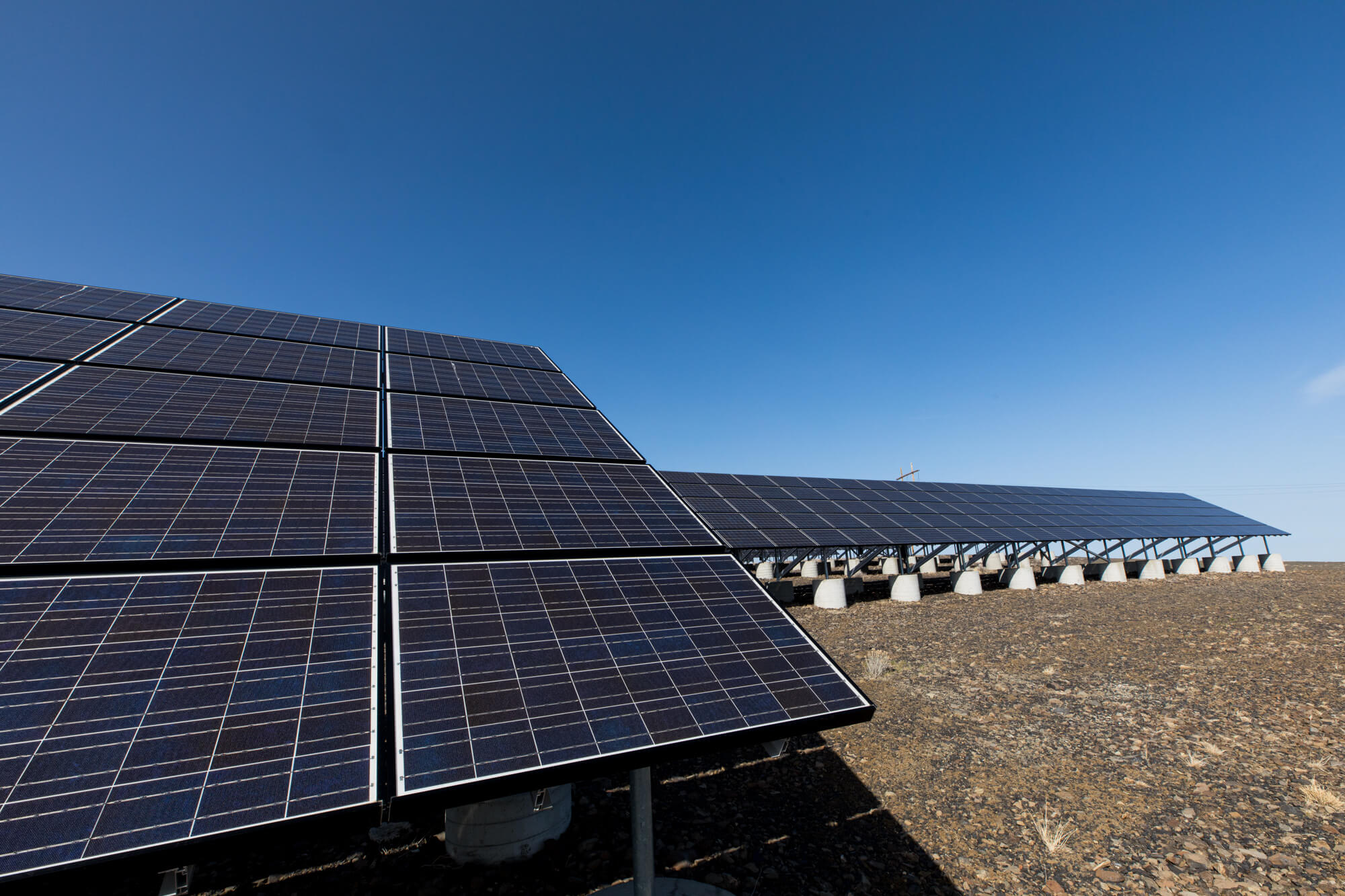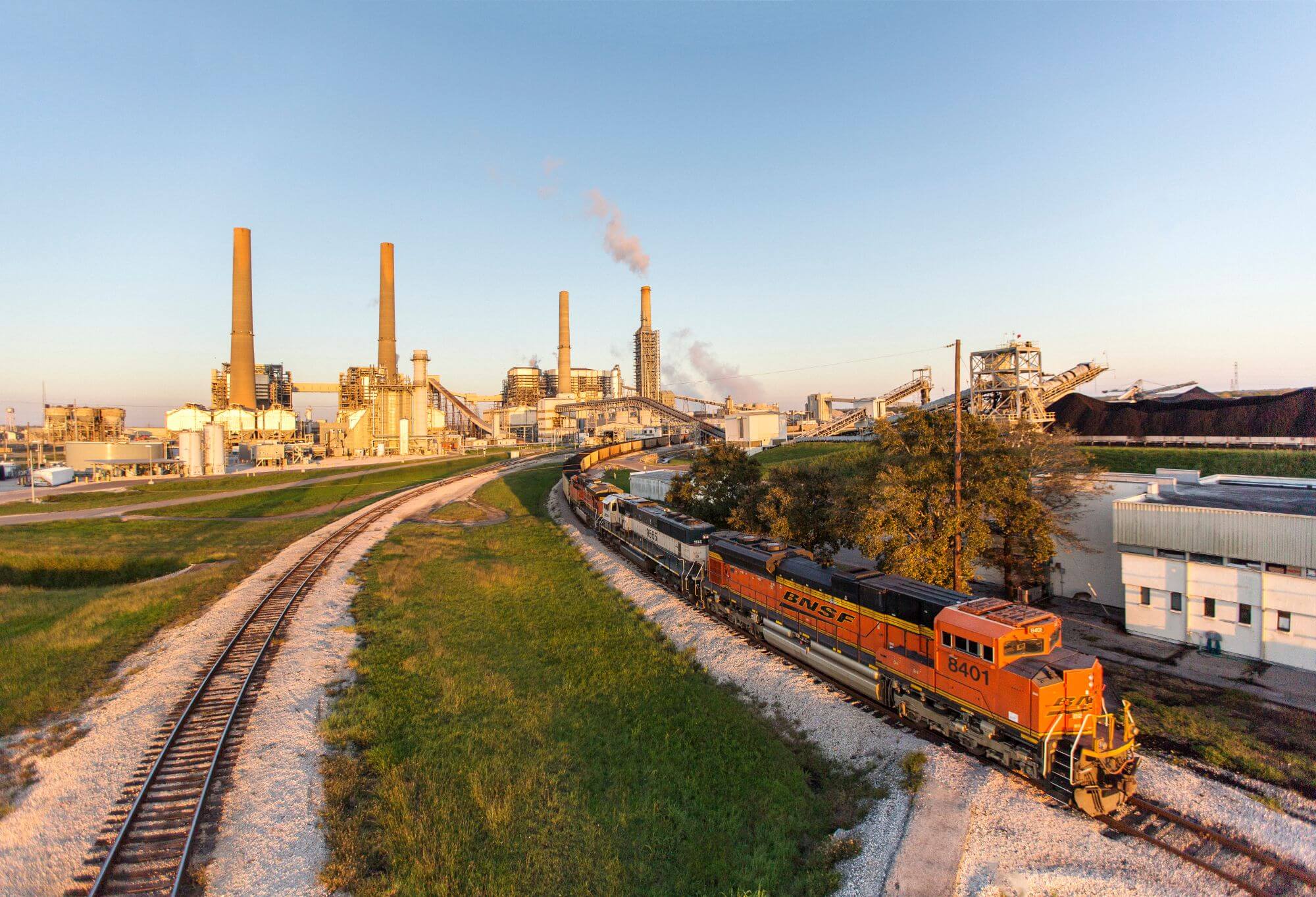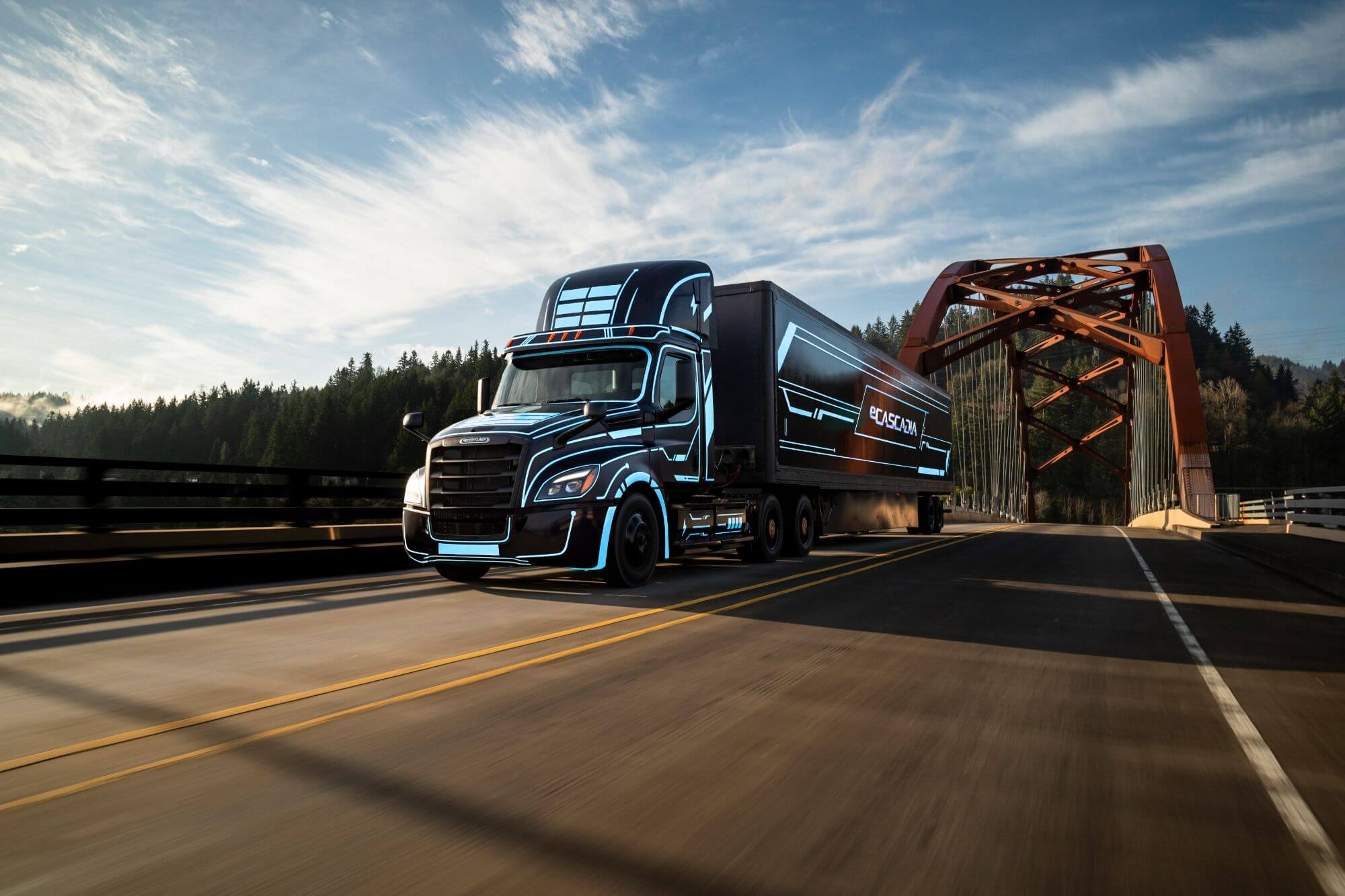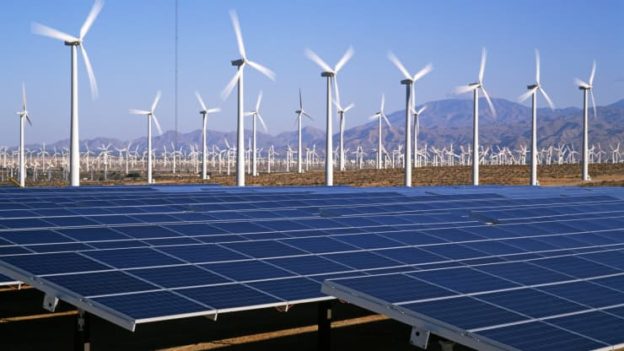Plugging in more stuff can slash Cascadia’s climate-warming emissions at modest cost. But that means moving much faster.
 Amid the 1970s Arab oil embargo, a gasoline company’s TV ads showed an aging wooden windmill. As the wind died, it slowed to stillness.
Amid the 1970s Arab oil embargo, a gasoline company’s TV ads showed an aging wooden windmill. As the wind died, it slowed to stillness.
The ad asked: “But what do you do when the wind stops?”
For the next several decades fossil fuel providers continued to denigrate renewable energy. Big power utilities piled on with claims that fluctuating solar and wind power could black out the grid. Even the U.S. Energy Department deemed renewables “too rare, too diffuse, too distant, too uncertain, and too ill-timed” to meaningfully contribute, as a top agency analyst put it in 2005.
Today we know that’s not true, especially in Washington, Oregon and British Columbia.
New research shows we are collectively poised to pioneer a climate-friendly energy future for the globe – that renewable electricity can not only move Cascadia off of fossil fuels, but do so at an affordable price while creating some jobs along the way.
After decades of disinformation, this may sound like a wishful vision. But building a cleaner and more equitable economy — and doing so in just a few decades to head off the worst effects of climate change — is backed by a growing body of regional and international research.
Getting off fossil fuels is “feasible, necessary … and not very expensive” when compared to the earnings of the overall economy, said Jeffrey Sachs, an economist and global development expert at Columbia University.
Much of the confidence about the price tag comes down to this: Innovation and mass production have made wind and solar power installations cheaper than most fossil-fueled power plants and today’s fastest-growing source of energy worldwide. The key to moving Cascadia’s economies away from fossil fuels, according to the latest research, is building more to make renewable electricity our go-to “fuel.”
However, doing that in time to help head off a cascading climatic crisis by mid-century means the region must take major steps in the next decade to speed the transition, researchers say. And that will require social buy-in.
The new research highlights three mutually supporting strategies that squeeze out fossil fuels:
- increasing energy efficiency to trim the amount of power we need,
- boosting renewable energy to make it possible to turn off climate-wrecking fossil-fuel plants, and
- plugging as much stuff as possible into the electrical grid.
Recent studies in Washington state and British Columbia, and underway for Oregon, point to efficiency and electrification as the most cost-effective route to slashing emissions while maintaining lifestyles and maximizing jobs. A recent National Academies of Science study reached the same conclusion, calling electrification the core strategy for an equitable and economically advantageous energy transition.
However, technologies don’t emerge in a vacuum. The social and economic adjustments required by the wholesale shift from fossil fuels that belch climate-warming carbon emissions to renewable power can still make or break decarbonization , according to Jim Williams, a University of San Francisco energy expert whose simulation software tools have guided many national and regional energy plans, including two new U.S.-wide studies, a December 2020 analysis for Washington state, and another in process for Oregon.
Williams points to vital actions that are liable to rile up those who lose money in the deal. Steps like letting trees grow many decades older before they are cut down, so they can suck up more carbon dioxide — which means forgoing quicker profits from selling timber. Or convincing rural communities and conservationists that they should accept power-transmission lines crossing farms and forests.
“It’s those kinds of policy questions and social acceptance questions that are the big challenges,” said Williams.
Washington, Oregon and British Columbia already mandate growing supplies of renewable power and help cover the added cost of some electric equipment. These include battery-powered cars, SUVs and pickups on the road. Heat pumps — air conditioners that run in reverse to push heat into a building — can replace furnaces. And, at industrial sites, electric machines can take the place of older mechanical systems, cutting costs and boosting reliability.
As these options drop in price they are weakening reliance on fossil fuels — even among professional chefs who’ve long sworn by cooking with gas (see Cooking quick, clean and carbon-free, below).
“For each of the things that we enjoy and we need, there’s a pathway to do that without producing any greenhouse gas emissions,” said Jotham Peters, managing partner for Vancouver-based energy analysis firm Navius Research, whose clients include the B.C. government.
Key to decarbonization planning for Cascadia are computer simulations of future conditions known as models. These projections take electrification and other options and run with them. Researchers run dozens of simulated potential future energy scenarios for a given region, tinkering with different variables: How much will energy demand grow? What happens if we can get 80% of people into electric cars? What if it’s only 50%? And so on.

Cascadia
Accelerating the transition requires large investments, this modeling shows. Plugging in millions of vehicles and heat pumps demands both brawnier and more flexible power systems, including more power lines and other infrastructure that communities often oppose. That demands both stronger policies and public acceptance. It means training and apprenticeships for the trades that must retrofit homes, and ensuring that all communities benefit — especially those disproportionately suffering from energy-related pollution in the fossil fuel era.
Consensus is imperative, but the new studies are bound to spark controversy. Because, while affordable, decarbonization is not free.
Projections for Washington and British Columbia suggest that decarbonizing Cascadia will spur extra job-stimulating growth. But the benefits and relatively low net cost mask a large swing in spending that will create winners and losers, and without policies to protect disadvantaged communities from potential energy cost increases, could leave some behind.
By 2030, the path to decarbonization shows Washingtonians buying about $5 billion less worth of natural gas , coal and petroleum products, while putting even more dollars toward cleaner vehicles and homes. No surprise then that oil and gas interests are attacking the new research.
And the research shows a likely economic speed bump around 2030. Economic growth would slow due to increased energy costs as economies race to make a sharp turn toward pollution reductions after nearly a decade of rising greenhouse gas emissions.
“Meeting that 2030 target is tough and I think it took everybody a little bit by surprise,” said Nancy Hirsh, executive director of the Seattle-based NW Energy Coalition, and co-chair of a state panel that shaped Washington’s recent energy supply planning.
But that’s not cause to ease up. Wait longer, says Hirsh, and the price will only rise.
Charging up
What most drives Cascadia’s energy models toward electrification is the dropping cost of renewable electricity.
Take solar energy. In 2010, no large power system in the world got more than 3% of its electricity from solar. But over the past decade solar energy’s cost fell more than 80%, and by last year it was delivering over 9% of Germany’s electricity and over 19% of California’s.
Government mandates and incentives helped get the trend started. Once prohibitively expensive, solar’s price now beats nuclear, coal and gas-fired power, and it’s expected to keep getting cheaper. The same goes for wind power, whose jumbo jet-sized composite blades bear no resemblance to the rickety machines once mocked by Big Oil.

The solar array at Puget Sound Energy’s Wild Horse facility east of Ellensburg Washington was the region’s largest at the time of its installation over a decade ago. But its 502-kilowatt output is dwarfed by the generation from each of the site’s wind turbines. Today solar is cheaper than wind power, per kilowatt, and the largest solar plants generate several thousand times more power than the Wild House array. (Photo: Dan DeLong/InvestigateWest)
In contrast, cleaning up gas- or coal-fired power plants by equipping them to capture their carbon pollution remains expensive even after decades of research and development and government incentives. Cost overruns and mechanical failures recently shuttered the world’s largest “low-carbon” coal-fired power plant in Texas after less than four years of operation.
Innovation and incentives are also making equipment that plugs into the grid cheaper. Electric options are good and getting better with a push from governments and a self-reinforcing cycle of performance improvement, mass production and increased demand.
Battery advances and cost cuts over the past decade have made owning an electric car cheaper, fuel included, than conventional cars. Electric heat pumps may be the next electric wave. They’re three to four times more efficient than electric baseboard heaters, save money over natural gas in most new homes, and work in Cascadia’s coldest zones.
Merran Smith, executive director of Vancouver-based nonprofit Clean Energy Canada, says that — as with electric cars five years ago — people don’t realize how much heat pumps have improved. “Heat pumps used to be big huge noisy things,” said Smith. “Now they’re a fraction of the size, they’re quiet and efficient.”
Electrifying certain industrial processes can also cut greenhouse gases at low cost. Surprisingly, even oil and gas drilling rigs and pipeline compressors can be converted to electric. Provincial utility BC Hydro is building new transmission lines to meet anticipated power demand from electrification of the fracking fields in northeastern British Columbia that supply much of Cascadia’s natural gas.

Retrofits enabled this coal power plant in southeast Texas to capture some of its carbon dioxide pollution, which was then injected into aging oil wells to revive production. But problems with the capture technology and of unexpected shutdowns, and energy-intensive technology made the plant’s coal-fired power — which is being priced out of the market by renewable energy — even less competitive. It was expected to run for 20 years, but survived three years before low oil prices shut it down last year. (Photo: NRG Energy)
Simulating low-carbon living
The computer simulation tools guiding energy and climate strategies, unlike previous models that looked at individual sectors, take an economy-wide view. Planners can repeatedly run scenarios through sophisticated software, tinkering with their assumptions each time to answer cross-cutting questions such as: Should the limited supply of waste wood from forestry that can be sustainably removed from forests be burned in power plants? Or is it more valuable converted to biofuel for airplanes that can’t plug into the grid?
Evolved Energy Research, a San Francisco-based firm, analyzed the situation in Washington. Its algorithms are tuned using data about energy production and use today — down to the number and types of furnaces, stovetops or vehicles. It has expert assessments of future costs for equipment and fuels. And it knows the state’s mandated emissions targets.
Researchers run the model myriad times, simulating decisions about equipment and fuel purchases — such as whether restaurants stick with gas or switch to electric induction ‘burners’ as their gas stoves wear out. The model finds the most cost-effective choices by homes and businesses that meet the state’s climate goals.
Rather than accepting that optimal scenario and calling it a day, modelers account for uncertainty in their estimates of future costs by throwing in various additional constraints and rerunning the model. (See Multiple Paths to Net-Zero.)
That probing shows that longer reliance on climate-warming natural gas and petroleum fuels increases costs. In fact, all of the climate-protecting scenarios achieve Washington’s goals at relatively low cost, compared to the state’s historic spending on energy.
The end result of these scenarios are net-zero carbon emissions in 2050, in which a small amount of emissions remaining are offset by rebounding forests or equipment that scrubs CO2 from the air.
But the seeds of that transformation must be sown by 2030. The scenarios identify common strategies that the state can pursue with low risk of future regrets.
One no brainer is to rapidly add wind and solar power to wring out CO2 emissions from Washington’s power sector. The projections end coal-fired power by 2025, as required by law, but also show that, with grid upgrades, gas-fired power plants that produce greenhouse gas emissions can stay turned off most of the time. That delivers about 16.2 million of the 44.8 million metric tons of CO2 emissions cut required by 2030 under state law.
All of the Washington scenarios also jack up electricity consumption to power cars and heating. By 2050, Washington homes and businesses would draw more than twice as much power from the grid as they did last year, meaning climate-friendly electricity is displacing climate-unfriendly gasoline, diesel fuel and natural gas. In the optimal case, electricity meets 98% of transport energy in 2050, and over 80% of building energy use.
By 2050, the high-electrification scenarios would create over 60,000 extra jobs across the state, as replacing old and inefficient equipment and construction of renewable power plants stimulates economic growth, according to projections from Washington D.C.-based FTI Consulting. Scenarios with less electrification require more low-carbon fuels that cut emissions at higher cost, and thus create 15,000 to 35,000 fewer jobs.
Much of the new employment comes in middle-class positions — including about half of the total in construction — leading to big boosts in employment income. Washingtonians earn over $7 billion more in 2050 under the high-electrification scenarios, compared to a little over $5 billion if buildings stick with gas heating through 2050 and less than $2 billion with extra transportation fuels.
Rocketing to 2030
Evolved Energy’s electrification-heavy decarbonization pathways for Washington dovetail with a growing body of international research, such as that National Academy of Sciences report and a major U.S. decarbonization study led by Princeton University. (See Grist’s 100% Clean Energy Video for a popularized view of similar pathways to slash U.S. carbon emissions, informed by Princeton modeler Jesse Jenkins.)
Washington’s projected future also broadly matches other research in Cascadia. Extensive modeling for BC by Navius Research shows electrification carrying the load.
Brianne Riehl, an environmental policy researcher and Navius’ communications manager, notes that the firm’s recent Canada-wide study with 62 different scenarios identified electrification as British Columbia’s primary carbon-cutter. As Navius described the road forward for BC’s provincially owned utility, BC Hydro, last year: “The results do not show a future where other potential low-(greenhouse gas) energy pathways out-compete electricity.”
Electrification even sweeps sectors that use British Columbia’s cheap home-drilled natural gas. Peters said that Navius’ model taps electrification for the “vast majority” of predicted emissions reductions from buildings, for example.
And its modeling foresees large-scale electrification of BC’s gas fields and the gas liquefaction plants under construction on the coast to ship liquified natural gas to Asia, which currently are fueled by gas itself.
The challenge is accelerating these transitions. Action by 2030 is needed across Cascadia to deliver on societal demand to fight climate change and to lay the tracks for the difficult, long-term task of squeezing out nearly all carbon emissions a few decades later.
In 2030 Evolved Energy’s optimal case for Washington foresees sales of electric cars, SUVs and pickups roaring from 7.3% of light-duty vehicle sales in 2020 to 85.2% in 2030. In that year’s simulation, Washingtonians buy more than 1 million electric vehicles and purchase 21% less gasoline and diesel fuel.
That, along with growing electrification of buses, buildings and more, requires infrastructure such as charging stations, some quick growth in electricity generation, and power lines to carry it. In Oregon and Washington, such investments may catch a tailwind if Congress backs President Biden’s $2-trillion infrastructure package. But building transmission lines requires tough negotiations with affected communities, which can be time consuming.
Revving up in BC likely means adding wind and solar plants faster than the province expected. Unpublished province-level findings from Navius’ most recent Canada-wide modeling found that electricity demand in British Columbia could increase by up to 30% by 2030.
BC Hydro has high hopes for its Site C hydropower project, which is under construction but struggling to overcome cost overruns, geotechnical challenges, and opposition from First Nations. But it may provide only one-third of the new power required.
Washington’s modeling points to an additional need for 2030: a big jump in supply for cleaner fuels. These would replace fossil fuels that drive heavy vehicles such as ships and airplanes and power industrial processes such as cement and steel foundries. These uses require a more intense energy source than electricity. (More on those fuels in next week’s installment of Getting to Zero.)
Overall, both studies suggest Cascadia can afford to transition to a low-carbon economy. Navius figures decarbonization will slow annual economic growth in British Columbia in 2030 by about a tenth, trimming it from a projected 2% to 1.8% in 2030. Economic analysis for Washington state by FTI Consulting also projected slower growth in the late 2020s and early 2030s, when extra energy costs are at their highest. It projects 10,000 to 15,000 fewer jobs to be created in Washington relative to the climate-be-damned growth scenario. The state’s current employment is about 3.3. million.
Embracing the messengers?
Burning less gasoline, diesel and natural gas produces cleaner air — something that’s not factored into most economic forecasting, including FTI’s costing for Washington. The cost of decarbonization in 2030 looks even more affordable when one considers avoided air and water pollution from burning fossil fuels, which studies show will reduce illness, lost work and school days, and premature deaths.
Avoiding climate damage, meanwhile, would pay even larger dividends in the long run. Scientists expect action by Cascadia to help slow impacts of climate change, reducing future costs for damages to property and infrastructure from megafires, larger storms, and sea level rise.
For Smith at Clean Energy Canada, electrifying is also a potent business opportunity for Cascadia. She urges British Columbia’s government and industries to forsake a dying dream of growing LNG exports and to instead stake the future on decarbonizing the province’s exports.
Smith points to BC’s aluminum, which, thanks to BC’s near-total reliance on hydropower, is gaining advantage as one of the world’s least carbon-intensive suppliers.
Companies like Tesla and BMW are looking for low-carbon aluminum, notes Smith: “I don’t think that most British Columbians realize that we have a nearly 100% emissions free electricity grid, nor what a competitive advantage it is.”
With more renewable power, the province can decarbonize all of its natural resource exports, including forest products and other metals such as copper, cobalt and nickel. “Branding BC that way, rather than as a fossil fuel exporter, will attract more investment,” she said.
Washington and Oregon could build on toeholds in clean-energy manufacturing, such as the Daimler plant that makes electric trucks in Portland and the eCascadia electric semi prototypes that Freightliner is assembling in Redmond, Oregon.

Early this month Daimler Trucks North American began signing up buyers for its eCascadia battery-powered semitruck, one of two electric models that Daimler expects to begin manufacturing late next year at the Freightliner plant in Redmond, Washington. The eCascadia will have a 250-mile range. Conventional semis can travel over 2,000 miles on a full tank of diesel. (Photo: Daimler Trucks)
But not everyone embraces an electrified future. Fossil fuel interests in Washington have called the modeling biased and are raising the specter of electrification-driven blackouts.
When asked to comment on the modeling for Washington, Jessica Spiegel, northwest region director for the Western States Petroleum Association, issued a statement saying that, “an all-electric economy is not a viable alternative.”
Natural gas interests are also pushing back. The Northwest Gas Association and other interests joined WSPA in a joint December 2020 letter attacking the modeling as “insufficient” and calling the state’s endorsement of electrification a result of bias: “Using this endpoint as justification, the strategy then makes determinations about the best path to get there,” they wrote.
Resistance to action toward accelerated electrification has been on full display in recent months as Washington’s Legislature considers an array of policies to encourage or mandate a transition to cleaner energy. One proposal backed by Washington Gov. Jay Inslee to restrict delivery of gas to new buildings by 2030 died early, under assault from the gas industry and some unions.
During a hearing on the Better Homes & Clean Buildings Bill, a lobbyist for Puget Sound Energy, a suburban Seattle-based investor-owned utility that sells power and is also Washington’s largest natural gas supplier, raised the threat of energy shortfalls, citing a 2019 study suggesting that power demand could soon outstrip supply as the region’s coal-fired power plants shut down.
Environmental advocates point out that oil and gas producers and distributors have a vested interest in opposing rapid reductions in petroleum and natural gas consumption. They also note that BP, an oil and gas major that operates Washington’s largest refinery, dropped its membership in WSPA over the group’s lobbying to block climate action.
Grid experts say the best way to ensure reliability is to get cracking on power system upgrades needed to support a larger supply of wind and solar power. Patrick Oshie, an energy policy expert and Washington’s representative on a regional power grid planning group, said Evolved Energy’s modeling demonstrated that the state “can progress to a zero carbon future” and indicated a “need for early action.”
Spencer Gray, the Portland-based executive director for the Northwest & Intermountain Power Producers Coalition, which represents many renewable energy developers, says ensuring Cascadia’s power supply is “solvable” without slowing decarbonization. What’s crucial, he says, is to strengthen the grid.
Gray and Oshie are two of the many experts working toward creation of a regional power market for the Western grid, which interconnects all of the electrical systems in the U.S. and Canada west of the Rockies. They are also working to accelerate expansion of power lines so that Cascadia and its neighbors can access more low-cost renewable energy, such as the excellent wind resources in Montana.
“Five to 10 years from now is when we need it,” said Gray. “We need to start getting the stuff financed and sited now.”
Why Renewable Electricity Powers Decarbonization — and Pays Off





